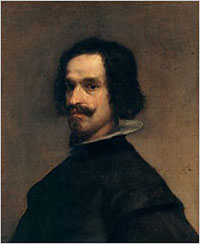 An Old Spanish Master Emerges From Grime
An Old Spanish Master Emerges From Grime For years the Metropolitan Museum of Art displayed the painting of a mustached man in his mid-30s on the same wall as famous portraits of Juan de Pareja and Maria Teresa, infanta of Spain by the 17th-century Spanish master Velázquez.
But was the canvas of the figure with the mustache, “Portrait of a Man,” also painted by Velázquez, as thought when it was bequeathed to the museum in 1949? Or was it merely from “the workshop of” Velázquez, as experts concluded a few decades later? After revisiting a painting that had raised nagging questions, a Met curator and a conservator finally have the answer.
“It’s bugged me for 25 years,” said Keith Christiansen, the Met’s newly appointed chairman of European paintings. “The quality has always been there. And I had a hard time believing that a work of quality was the product of a generic workshop.”
Experts had reason to doubt the authorship: Decades of varnish had discolored the canvas so much that its palette looked far darker than that of other paintings by Velázquez. The painting had been heavily restored and cleaned in the 1920s and revarnished in 1953 and again in 1965. In 1960s a leading scholar demoted it to the workshop of Velázquez and by 1979, the museum had downgraded the painting as well.
Still, when the museum recently started to catalog the Spanish paintings in its collection, Mr. Christensen asked Michael Gallagher, chief of the Met’s paintings conservation department, to take another look. He ended up not only studying the painting but also carefully cleaning and conserving it. As details like the individual brushstrokes of a collar emerged, he concluded that Mr. Christiansen’s instincts were on target. Buried beneath decades of yellowed varnish and poor retouching were all the marks of Velázquez’s hand.
Convinced that the picture was indeed by the master, he and Mr. Christiansen showed it to Jonathan Brown, this country’s leading Velázquez expert, who agreed.
“One glance was all it took,” Mr. Brown said, adding later, “The picture had been under my nose all my life. It’s a fantastic discovery. It suddenly emerges Cinderella-like.”
The painting was so dull before it was cleaned that Mr. Brown said he didn’t think it was a Velázquez. But after the varnish and the layers of paint — additions made centuries later to make the canvas look more old-masterish and entice buyers — were removed, “all the liveliness of the artist’s brushstrokes and all the subtleties that for decades had been covered over were revealed.”
The discovery, he added, is particularly significant because “Velázquez was a painter who measured out his genius in thimblefuls.” His output was so small that, depending on who’s counting, Mr. Brown estimates, there are only 110 to 120 known canvases by the artist.
To a conservator, Mr. Gallagher said, the prospect of working on the painting was daunting. The canvas was so dark, “it was like looking at the bottom of a murky pond.” The synthetic varnish had deteriorated, as had some of the layers painted over the original.
He began gingerly, performing a test on a tiny portion, removing varnish with an organic solvent. The murky green background suddenly became gray after it was cleaned. The densely painted face showed a vibrancy that had been obscured as had the small number of brushstrokes needed to evoke the man’s detailed white collar. His eyes turned out to be haunting and his brow bushy.
The painting’s history is fairly well documented: It was left to the museum by Jules Bache, a collector who headed an American brokerage firm before World War II and who was a major benefactor to the Met. Bache bought the painting from Joseph Duveen, the legendary dealer, in 1926 with the understanding that it was a self-portrait by Velázquez. Bache paid $1.125 million for the work, a huge sum back then (about $13 million in today’s dollars), although experts today say the canvas is worth about $40 million.
Its royal provenance added to the value. Before Duveen, it belonged to Count Johann Ludwig von Wallmoden-Gimborn, the illegitimate son of George II of Britain, and later to the last king of Hanover, George V.
When Duveen had the painting, Mr. Christiansen and Mr. Gallagher said, the portrait’s informal quality was not necessarily considered as commercial as a full-blown old master so the dealer “tidied it up,” as Mr. Gallagher put it, or painted over parts to make it look old-masterish.
“The picture was thinly painted and never intended to be finished,” said Mr. Christiansen, who says he believes it was actually a study. “It was a sitting done from life, which gives it great immediacy. The figure of the man is more finished than the costume or the background.”
The figure’s face, tired eyes and nose bear an eerie resemblance to the man looking out at the viewer from the far right of Velázquez’s “Surrender of Breda” (1634-35), which he painted to commemorate the Spanish victory over the Dutch. That painting, which is in the Prado Museum in Madrid, dates from around the same time as “Portrait of a Man,” made when Velázquez was 35.
But at this point nobody knows for sure if the figure in “The Surrender of Breda” or the man in the Met’s canvas is the artist himself. Other depictions of Velázquez, in “La Meninas” at the Prado, for instance, were painted when he was 57.
“Why not be a self-portrait?” Mr. Christiansen said. “It might be fun to put it on a blog on the museum’s Web site and ask people to take a vote.”
